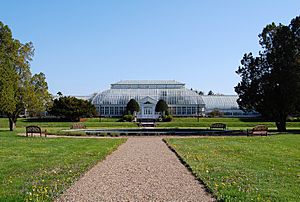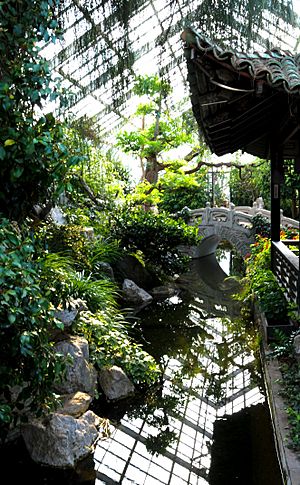Duke Gardens (New Jersey) facts for kids
Duke Gardens in Somerset County, New Jersey, were once a very important collection of plants grown inside large glass buildings called greenhouses. These gardens were created by Doris Duke herself. They were even bigger than the main conservatory at the New York Botanical Garden.
Duke Gardens first opened to the public in 1964. However, they were closed by the Doris Duke Charitable Foundation on May 25, 2008. After closing, many of the plants were given to other public gardens across the United States.
Contents
History of Duke Gardens
Duke Gardens were part of a huge property called Duke Farms, which was about 2,700 acres big. This estate was built by James Buchanan Duke, who started the American Tobacco Company. He also helped create Duke University.
Duke Farms is located in Hillsborough Township, New Jersey. The gardens were designed and built by Doris Duke, James Buchanan Duke's daughter. People sometimes called them by other names, like The Doris Duke Indoor Display Gardens. Officially, they were known as The Duke Gardens Foundation, Inc.
Miss Duke created these amazing gardens to honor her father. She was inspired by another famous garden called Longwood Gardens in Pennsylvania. Each of the eleven Duke Display Gardens was a full-size copy of a garden from a different country or time period.
Building the gardens began in 1958. Miss Duke worked very hard on the design and even helped with the building herself. She sometimes worked for 16 hours a day! In 1960, she gave 10 acres of her land, including the greenhouses, to the Duke Gardens Foundation.
Doris Duke continued to be involved with her gardens throughout her life. She brought in designers to change them when they were closed in the summer. In the 1970s, she added special lights so people could visit the gardens at night.
What Were the Gardens Like?
Duke Gardens were arranged in a square shape. It took at least an hour to walk through them all. The main entrance was through a large building called a Conservatory, built between 1909 and 1917. The other sides of the square were made up of other greenhouses.
Visitors usually saw the gardens in this order:
- Italian Courtyard: This was the main entry area. It had statues among beautiful plants, including a copy of a famous sculpture called The Three Graces.
- Colonial Garden: This garden showed plants typical of the southern United States. It had camellias, azaleas, magnolias, and crepe myrtles.
- Edwardian Garden (Fern and Orchid House): This section was filled with different kinds of ferns and beautiful orchids.
- French Parterre: Here, flowers were planted in neat, geometric patterns.
- English Gardens: This area had five smaller gardens. These included a topiary (plants shaped like animals or objects), a rock garden, and an Elizabethan knot garden from the 16th and 17th centuries. There was also an 18th-century garden with succulent plants.
- American Desert: This garden featured cacti and other succulent plants. You could see barrel cactus, giant aloe, and crown of thorns plants.
- Chinese Garden: This peaceful garden had a stream with koi fish and interesting rock formations. It also featured bamboo, camphor trees, and jasmine.
- Japanese Garden: This section had a tea house and tiny bonsai trees, along with red maples.
- Indo-Persian Garden: This garden had water features, fountains, and carved marble screens. It grew orange trees and Mediterranean cyprus trees, plus a Persian rose garden.
- Tropical Garden: This greenhouse was home to many tropical trees and vines.
- Semi-Tropical Garden: Here you could find plants like papyrus, fiddlehead ferns, and Bird of Paradise flowers.
Why Duke Gardens Closed
In March 2008, Duke Farms announced a new plan for its large property. They decided to focus on becoming a center for environmental education. Because of this new goal, they decided to close the 11 indoor display gardens in May 2008.
The people in charge said that the gardens were very expensive to keep up. They also felt the gardens needed a lot of costly updates. They believed the gardens no longer fit with the new vision for Duke Farms. A video was made to record the gardens for history.
Officials said that some of the plants from the old gardens might be used in new designs. However, the new gardens would not be copies of the "gardens of the nations." Instead, they would focus on connecting local plants with exotic ones. Any leftover plants were given to other botanical gardens.
When the closure was announced, many people were upset. Letters of protest appeared in local newspapers. A website called SaveDukeGardens.org was created to allow people to send emails to the leaders of the Doris Duke Charitable Foundation. A group was also formed on Flickr, a photo-sharing website, to share pictures of the gardens.
New Gardens at Duke Farms
The Duke Gardens Foundation was created in 1959. Its goal was to "maintain a horticultural and botanical establishment for the purpose of scientific experimentation and public education and enjoyment."
After Duke Gardens closed, the Duke Farms Foundation created new indoor and outdoor display gardens. These new indoor gardens are in a renovated building called the Orchid Range. Duke Farms reopened to the public with these new attractions on May 19, 2012.
Images for kids
See also
 In Spanish: Jardines Duke para niños
In Spanish: Jardines Duke para niños






